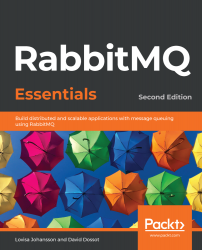CC's drivers and customers are enjoying the request taxi feature that was rolled out in Chapter 2, Creating a Taxi Application. First, publishing messages to the direct exchange for customers ordering a single taxi was explained, and then instructions were given on implementing the topic exchange, which customers use when ordering a taxi with specific requirements. In both cases, the consumer is bound to the channel that was used to consume a particular queue. If this channel was closed, the consumer would stop receiving messages. Because a channel cannot be reopened and has to be recreated from scratch, both the channel and its consumption must be re-established if there are any problems.
Let's walk through some important points about consumers and queues in RabbitMQ:
- A queue can have multiple consumers (unless the exclusive tag is used).
- Each channel can have multiple consumers.
- Each consumer uses server resources, so it is best to make sure...



